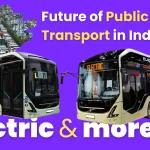The journey to e-bus is a way to turn to green and sustainable urban transport. However, some electric bus myths are still considered valid regarding the viability and effectiveness of offshore outsourcing options. We are debunking the electric bus myths, such as electric bus range anxiety, electric bus charging time, electric bus battery life, and good health relations. We will demystify the identified electric bus myths and showing how moving towards sustainable mobility can be fun without any hassles.
Myth 1: Electric bus range anxiety
It may be shocking for many people to know that most electric bus myths have a connection, and one of them is the electric bus range anxiety, which keeps people from using e-buses because they fear that the bus will not have the necessary range to complete a particular line without recharging frequently. This is more of an old school thinking when electric vehicles were first invented and electric bus battery life technology was less developed.
The Reality
Today’s e-buses are built with contemporary electric bus batteries that provide sufficient electrical energy storage. For example, a BYD K9 e-bus can extend its range to up to 250 kilometres (155 miles) with only a single charge. This is enough for most cityscape routes, as the daily distances for most routes average from 150 to 200 km.
Furthermore, such problems were not acute in cities that included e-buses in their transport fleet without critical failures—presenting an example of over 16,000 e-buses running in Shenzhen, China, which pretty much negates the electric bus range anxiety narrative with current technology.
Myth 2: Electric bus charging takes a long time
Another common electric bus myth society considers is the charging time, similar to the case of electric cars, where it is a critical factor. A couple of applaudable points that critics have pointed out are that the long charging time could have operational consequences since buses would need to be charged often, implying that they would be off-road most of the time.
The Reality
The choice of the aspect of charging technology that has rapidly developed. These systems can decrease the electric bus charging time which means that e-buses can be used for daily operations. For instance, an electric bus with a fast-charging technique can regain power to the level of at least 80% of its capacity within 1-2 hours at most. Furthermore, sites that will offer ultra-fast electric bus charging are also being constructed, which will provide an even faster rate for swapped vehicles.
Further, techniques like over-night depot charging and opportunity charging at bus stops or terminals facilitate, that e-buses remain in use the entire day. Opportunity electric bus charging time is applied in Gothenburg, Sweden where buses are charged quickly at some points on a route in order to spend a short time on electric bus charging time.
Myth 3: Limited Battery Life for E-Bus
Some of the issues that are associated with e-bus batteries include; electric bus battery life lifespan where after sometimes one is forced to replace them as they only have a short lifespan and the costs that are incurred in replacing them.
The Reality
Battery technology has progressed in two main areas: longevity and the cost of production. The lithium-ion batteries introduced in today’s e-buses are meant to serve the aggregate period of their use to which they can be subjected, 8-12 years. For instance, Proterra, an American e-bus manufacturer, provides an electric bus battery life warranty of 12 years of service life remaining.
Besides, the costs of batteries have been on the progress of declining for a long time. In its noted that, the cost of lithium-ion batteries has been slashed by 89% within the last ten years. Said decrease in cost along with the electric bus advantages on the fuels and maintenance portray the economics of electric buses with e-bus performance concerns addressed and leading more favourable uses.
- The Future of Public Transport in India: Are Electric Buses the Answer?
- Global Recycling Day 2025: A Call to Action for a Sustainable Future
- Your Journey, Your Opportunity: How Zingbus is Revolutionizing Intercity Bus Travel in India
- 10 Best Places to Celebrate Holi Near Delhi (with DJs and Celebs!)
- Holi in India vs. International Holi Festivals: What’s the Difference?
Myth 4: Is the electric bus efficient?
One of the many electric bus myths surrounding electric buses for improved efficiency is the bad perception that electric bus efficiency is lower than diesel ones, especially in their energy consumption levels and general operations.
The Reality
Surprisingly, e-buses are even more profitable than diesel buses in most dimensions. Electric motors, as we all know, are generally superior to internal combustion engines and can convert more than 85% of electric energy into movement, while the diesel engine can convert 20-30% of energy into movement only. Improved electric bus efficiency leads to low operational costs and fewer emissions to the environment.
In addition, e-buses offer the feature of regenerative braking in which energy from braking can be recovered and stored in the electric bus battery life. This feature enhances the energy conservation, and at the same time, the stress applied to the braking system is minimized.
Efficiency in Real-World Scenarios
Empirical evidence for electric bus efficiency is available that will pinpoint the fact that e-buses are more efficient in the real world. Governments in many countries are increasingly adopting the use of e-buses because their operational cost is low, as we have seen in the case of London, and also improved electric bus efficiency.
This London’s transport company also confirmed that e-buses are cost efficient, and they can cost up to 70% of the energy of diesel buses. Moreover, through the use of e-buses, the environment is conserved anew through reduced air pollution and low noise pollution in their operation.
Myth 5: The Reality Addressing E-Bus Performance Concerns
However, there are still issues with the e-bus performance concerns, which people still worry about, especially how these e-buses would perform on different terrains and extreme weather conditions.
The Reality
Thus, e-buses are created to be suitable for usage in different geographical routes and weather conditions. For instance, Mercedes-Benz eCitaro has been run in different weather conditions, including cold climate of Sweden and hot climate of Spain and it has also been able to prove the electric bus efficiency.
Moreover, electric buses are fit with some of the most efficient and sophisticated thermal management systems that enhance electric bus battery life and functioning as well as durability, in regard to external climatic condition. This capability guarantees that the e-buses can in fact run optimally and effectively in such conditions.
Electric Bus Advantages
Environmental Benefits
E-buses emit zero tailpipe emissions which drastically decreases Green House Emissions and enhances the quality of air in the cities as a core electric bus advantage. This decrease plays a significant role in the strategies used to limit climate change and preserve the wellbeing of citizens. The International Council on Clean Transportation (ICCT) has done research that shows that the use of e-buses has to capability of cutting down on CO2 emissions within a range of 70- 75% as compared to diesel using ones.
Cost Savings
The initial purchases’ cost of e-buses can be higher than those of traditional diesel buses but the overall ownership costs (TOC) are generally lower. Reducing fuel consumption, service and operating expenses are at the root of pointing the argument that electrically powered buses are economically viable in the long-run strategy. For instance, the National Renewable Energy Laboratory (NREL) examined the expenses tagged to e-buses and discovered that they are $300,000 cheaper compared to diesel buses in their entire life cycle.
Enhanced Passenger Experience
E-buses also produce less noise as oppose to Diesel buses making it quieter when they are in operation. Lack of sound and shaking effect from the engine makes travel in a vehicle convenient and makes people prefer public transportation. Moreover, e-buses are designed with the inclusions of amenities like wireless fidelity, also known as Wi-Fi, and Universal Serial Bus, USB charging points again enhancing the experience of the passengers.
Policy and Funding Support
The governments and organizations in India have embraced and patronized policies and funding to support e-buses. Grants, subsidies and tax credits offered by governments are enabling the transit agencies work towards green by shifting to electric buses.
Conclusion
To dispel the negative electric bus myths tied to the use of e-buses, one has to consider that these vehicles are a rather suitable and effective type of transport for contemporary cities. Battery technology, charging systems, and overall efficiency of electric buses have improved over the years dispelling most of the misconceptions people had with e-buses.
Electric bus myths surrounding includes electric bus range anxiety, electric bus charging time, electric bus battery life, and the e-bus performance concerns are gradually being erased by facts and technologies. With more cities across the globe turning their attention to e-buses, the electric bus advantages which include the social, ecological, economical, and the passengers’ benefits as electric bus advantages are reaped in the long-run.
The transition to e-buses is not just a trend but a necessary evolution in our journey towards sustainable urban mobility. By busting these electric bus myths and addressing e-bus performance concerns, we can accelerate the adoption of e-buses and pave the way for a cleaner, greener future.






Leave a Reply